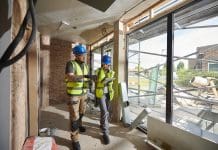Edonis Jesus, Chair of the BIM4Heritage Group and BIM Leader, Consulting – Europe at Lendlease explains how data and heritage modelling can be used in conservation
The BIM4Heritage is a special interest group established within the BIM4Communities to champion Building Information Modelling (BIM) within the historic environment. The group is a member of the UK BIM Alliance, which is a cross-industry alliance formed to lead BIM Level 2 and the digital formation of the construction and infrastructure sectors.
The purpose of the BIM4Heritage Group is to promote the learning, awareness and understanding of BIM within the conservation and heritage sector of the built environment, and to influence and integrate this with wider industry needs.
The group is formed by various specialists, including those from within the AEC industry, conservation, heritage organisations, academic departments and end-users.
Member organisations include: Alan Baxter, APM, Arup, BIM Task Group, BHA, British Museum, CIAT, CIOB, COTAC, DJA, English Heritage, Historic England, Historic Environment Scotland, ICOMOS, IHBC, Lendlease, MOLA, MRDA, National Trust, Office of Public Works, Page Park Architects, Parliamentary Estate Directory, Plowman Craven, Purcell, Royal Academy of Arts, Ramboll, University of East London and University of Reading.
The committee management team comprises of:
- Edonis Jesus (Lendlease) – Chair
- Ingval Maxwell (COTAC) – Vice-Chair
- Paul Bryan (Historic England)
- Steve Scaysbrook (CIAT)
In my previous article for PBC Today, we gave an introduction of the BIM4Heritage group, its goals and objectives. In this article, we look at what the group has been doing in the months since its formation, and what its plans are for the future.
Since its formation in July 2016, the group meets regularly to discuss the potential of BIM within the heritage sector and to share experiences and lessons learnt on the application of BIM in the historic environment.
With such a diverse range of experience in the room, it was decided that each meeting would include at least one case study presentation by a member, highlighting the benefits and limitations of BIM implementation on recent heritage projects.
Through the Q&A and in-depth discussions that followed each case study, the group has identified and continues to identify, several core areas that require development. Some of these core areas for development can be summarised under the following headings:
Heritage Modelling:
This includes defining different modelling methods (survey/scan to BIM, libraries, etc.) and when they should be used, proposing a Level of Detail definitions table for heritage objects and establishing which LOD is appropriate for use in each situation and other technical issues.
Heritage Information (data) requirements:
This includes defining an outline of the BIM information deliverables required for conservation, repair, and maintenance projects.
The group now aims to develop strategies and guidance notes to overcome these challenges, and hopes to equip the sector by providing leadership in establishing how BIM can be implemented in heritage conservation, repair and maintenance processes. The group also aims to develop several case studies that demonstrate best practice procedures on the application of BIM within the heritage sector.
Technical papers are now available on the “Technical Standards” page of the group website, which will continue to populate as more research is undertaken. Submissions for the site are welcomed from members, non-members, & academics alike.
In addition to the work being done in the development of these technical elements, the group is also actively involved in hosting and speaking at conferences to further awareness and encourage the participation of those involved in the historic environment sector.
Ramboll and COTAC hosted a conference recently called: ‘BIM4Heritage: Where We Are and Where We Are Going’ in London on the 9th December 2016.
Conceived as a ‘warts and all occasion’, the conference aimed to provide an honest appraisal of the use of BIM within heritage buildings and their environments and to provide guidance on how BIM might be adopted for the range of heritage conservation, repair and maintenance processes. In reviewing the risks and opportunities concerning the specific adoption of BIM, and to explore its increasingly advanced applications, speakers were invited to address the following topics:
- BIM de-bunked
- Capabilities of information capture
- The conservation conundrum
- BIM sensitive analysis
- Beyond the clouds
COTAC is preparing a report on the conference, and this will be made available on the COTAC and BIM4Heritage websites.
The main events on the calendar for 2017 so far include the official BIM4Heritage launch event, but the group is currently looking at other events opportunities such as the GEO Business 2017 show.
BIM4Heritage has enjoyed a productive and eventful first few months and expects to continue from strength to strength as the group gains momentum and works towards achieving its goals.
Edonis Jesus
BIM Leader, Consulting – Europe
Lendlease
Edonis.Jesus@lendlease.com













